When you’re sitting or lying down near the edge of your mattress, do you feel like you’re going to fall off the bed? If so, your mattress may not have great edge support.
When reviewing mattresses, we pay close attention to edge support. Keep reading to learn more about our testing methodology and what gives a mattress good edge support.
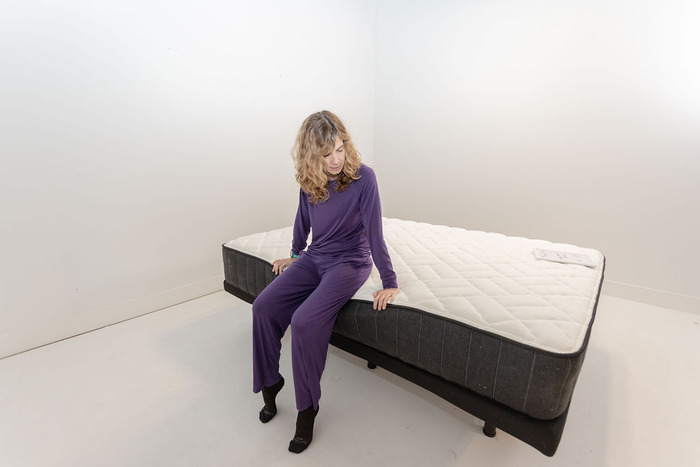
Why Is Edge Support Important?
There are several benefits to sleeping on a mattress with excellent edge support. Because the edges are reinforced, they improve the durability and performance of the mattress. Edge support can help prevent your mattress from sagging, make it easy for you to get in and out of bed, and provide you with extra space to sleep.
On the other hand without proper edge support, you’ll likely feel unstable when you lie or sit near the side of the bed. This diminishes the surface area you can use for sleeping, and, in a worst-case scenario, can cause you to roll from the edge right onto the floor.
Who Should Look for Beds with Strong Edges?
Though everyone can benefit from a mattress with good edge support, there are a few people who may want to keep it top-of-mind.
People with Small Beds
If you sleep on a twin or twin XL mattress, one toss or turn can result in sleeping on the very edge of your bed. People with small beds don’t have much surface area to sleep on, so what little space they have should offer plenty of support. Beds with excellent edge support ensure sleepers have plenty of room to rest and can help prevent sleepers from falling off of the side.
Couples
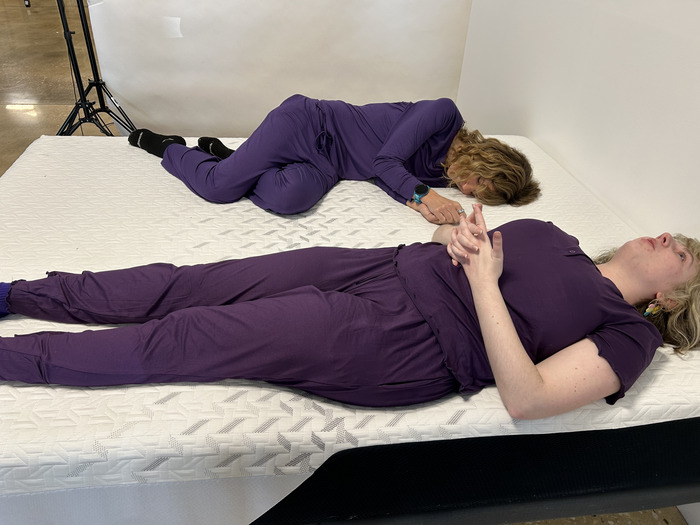
If you share a bed with a partner, you’ll want to make sure your bed feels supportive around the sides. If the edges cave in, you’ll be forced to sleep closer toward the center of the mattress. This means you won’t be able to utilize the full surface area of the mattress, which can make you feel cramped and uncomfortable.
Older Adults and People with Mobility Issues
People with decreased mobility may find it difficult to quickly get in and out of bed. Edge support can be particularly helpful for easing this process. Without it, the sides of the bed will sink and may cause someone to slip off. That’s why we recommend that older adults, people with arthritis, and people with joint pain buy a mattress with stellar edge support.
How We Test Edge Support
We thoroughly test each mattress we review, and award it an edge support score between 1 and 5 (with 5 indicating amazing edge support). Here’s a peek behind the curtain about how we assess a mattress’s edge support.
Seated Test
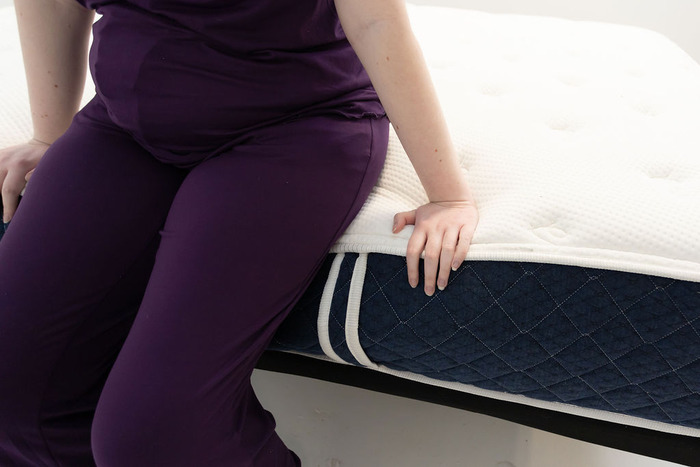
Because not every person experiences edge support the same, it’s important to get a variety of perspectives when testing mattresses. That’s why multiple people test each mattress for edge support and share their notes.
First, a tester will sit along the side of the mattress and see how far they sink into the layers. They’ll also get up and down from the bed several times to see how the edges hold up during this process.
Full-Body Test

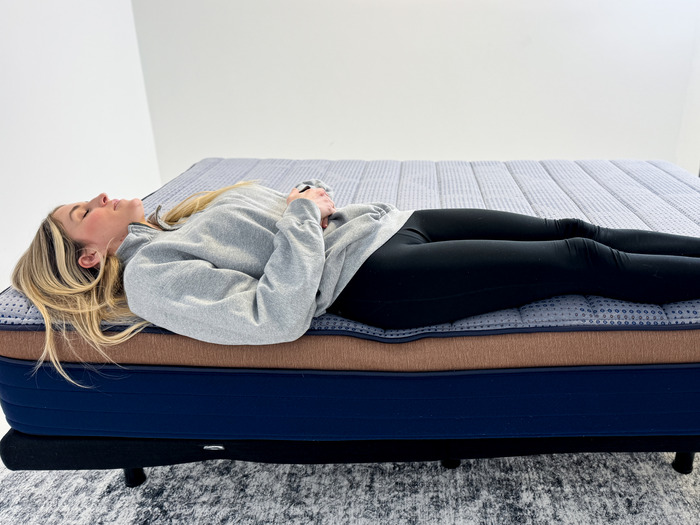
Next, testers take turns lying down in every sleeping position near the edge of the mattress. If they feel like they might roll off the side of the bed, they lower the edge support rating.
Tape-Measure Test
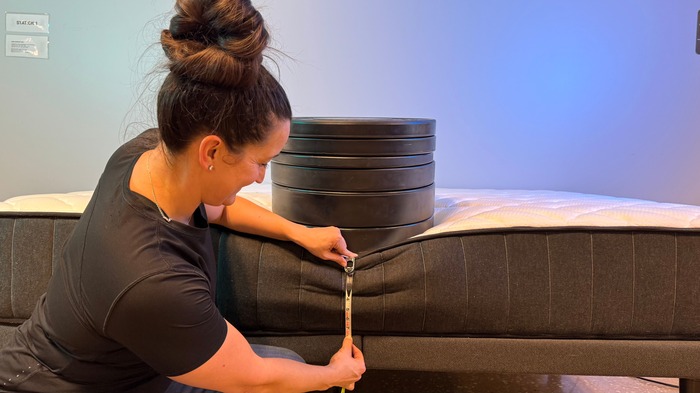
We also measure edge support by seeing just how much the sides of the bed sink when weight is applied. To do this, we stack weighted plates on the edge of the bed, then use a tape-measure to asses the depth of the sinkage. If the perimeter doesn’t sink beyond 5 inches or so, the edge support is quite sound.
What Gives a Bed Good Edge Support?
A mattress’s edge support greatly depends on what it’s made out of. High-density foam doesn’t usually offer as much support as innerspring coils do.
Many mattresses have reinforced edges. This extra padding is either made from dense polyurethane foam or pocketed coils, which can help prevent sleepers from rolling off the side of the bed.
Let’s go over different types of mattresses by material and see how they typically perform in our edge support testing.
Memory Foam
In our experience, all-foam beds don’t have the best edge support. The slow-moving comfort layers often sink when pressure is applied, and they can make some people feel like they will roll off the bed.
That said, not all memory foam mattresses have poor edge support. Some have a denser foam around the perimeter that can shore up the edges considerably.
Hybrids and Innersprings
Both hybrid and innerspring mattresses have coils in the support layers. Generally, these types of mattresses have better edge support than all-foam beds. That’s because coils are stronger than foam and don’t sag as much as time goes on. Take a look at our list of the best hybrid mattresses for some good options.
Latex
All-latex and latex hybrid mattresses often have great edge support. That’s because latex is a naturally supportive material. It’s also quite durable–some latex mattresses can last over 15 years. Because this material doesn’t sag as time goes on, it offers plenty of support.
FAQs
What is edge support in a mattress?
Edge support refers to how comfortable and sturdy the perimeter of your mattress feels. A mattress with excellent edge support will allow you to securely and comfortably sit or lie near the edge without feeling like you will fall off.
How do you fix mattress edge support?
If your mattress is sagging or is lacking edge support, there are a few ways you can temporarily improve your bed’s level of support. First, try rotating your mattress. If that doesn’t help, you can add a firm mattress topper to add support near the edge of your bed. Next, consider replacing your mattress’s foundation or bed frame if it is not providing you enough stable support. If none of these methods work, it may be time to replace your mattress.
Which mattresses have the best edge support?
Hybrid and innerspring mattresses typically have the best edge support because coil layers are more durable and supportive than high-density foams. Mattresses with reinforced edges are also less prone to sagging.
What is a reinforced edge on a mattress?
Some mattresses have reinforced edges that offer extra support around the perimeter. This edge can be made out of pocketed coils or high-density support foam to ensure your mattress won’t sag when you sit or lie near the edge.

